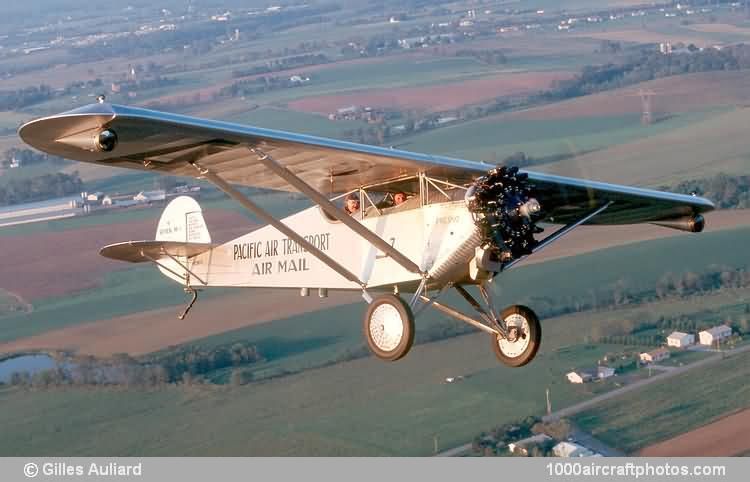Six examples were delivered in 1926, equipped with Wright J-4 engines, operating on Contracted Air Mail Route number 8 between Seattle, Washington, USA and Los Angeles, California, the longest and toughest CAM early route. It was the first commercial type flying with Pacific Air Transport (P.A.T.), one of the three companies later merged to create United Air Lines, starting September 16, 1926.
Five of the six Ryans, including c/n 7 crashed during the first year of operation of the line, killing at least one pilot. The paperwork for c/n 7 survived and was later acquired by Andrew King to register his restored Ryan.
He discussed his plans to restore an M-1 with most of the pilots who would show up at his shop. One day, one of them told him: "there is the fuselage of one of those sitting in a barn 30 mls (48 km) from here...". "Yeah, right", Andrew thought. But this was true. Bob Buck, a United Air Lines Pilot had acquired the Ryan as part of a deal involving a Curtiss-Wright 16E and stored it in his barn.
Andrew comments on the restoration process: "I started the project in March 1995, with the original fuselage and an original strut, although most of it was unusable and good only as a pattern. The fuselage and tail surfaces are steel tube structures and the wing is wood, mostly spruce, with metal fittings. I carefully collected all the proper instruments, as well as important air mail related items, like the landing light and the emergency landing parachute flare tubes, behind the pilot's seat. The engine is a 260 hp Lycoming nine-cylinder radial, the original being a nine-cylinder Wright J-4"
Andrew found a set of legal papers for c/n 7, so the airplane is registered with the FAA under that identity. Oddly enough, Bob Buck was in possession of the data plate for number 11, but did not have any paperwork for it. He explains: "At the time of the start of the project we did not know the identity of the fuselage we were working on. There where several modifications, such as an extra piece of tubing, some fittings for a brake system and some extra metal sheeting in the front. Those elements were not consistent with the P.A.T. M-1s. Going through the archives at the San Diego Aerospace Museum, I found a picture of a fuselage on the assembly line modified exactly like it. It was shown next to the Ryan ST prototype, and was identified as number 11. So, I am 99% convinced that the fuselage is that of c/n 11." It appeared that Andrew was in possession of the M-1 flown by Lindbergh!
Lindbergh flew it on June 11, 1928. It crashed in 1930 and ended up at Balboni's Junkyard, in Los Angeles, where a couple of Ryan Aeronautical students bought it. The airplane was rebuilt adding sheet metal and extra fittings that Andrew discovered later during restoration. The airplane was involved in another accident in 1936, and the paper trail stopped there.
The engine was found by Kent Mc Makin of Brodhead, Wisconsin, USA. Taken out of a PT-22 that was modified in the1960s, the Lycoming was overhauled by Jack Lanning, in Arlington, Virginia, USA, one of the east coast prime specialist of older Wright, Continental and Lycoming engines. According to Andrew, it hardly uses any oil (for a radial engine, about 1 quart every 4 flying hours), and has performed flawlessly.
The first post-restoration flight was a short 20 minutes hop that did not reveal any problem with the airplane. Now, Andrew is the proud owner of the only flyable Ryan M-1. After clocking some 70 hours on the machine, he describes its flying characteristics: "The M-1 is surprisingly stable in flight. The pressure to maintain on the rudder and the elevator are normal for plane of that era, however, the ailerons are very heavy, and require two hand operation at most times. Otherwise, it is a very nice flying machine, but the forward visibility is limited by the parasol wing. The cruising speed is about 110 mph (177 kmh), and 45 mph (72 kmh) over the threshold. Comparing the M-1 to the other machines of the time, one can understand why Lindbergh fixed his choice on the Ryan for his Atlantic crossing project."
Visible in the background of this additional photo is this Winstead Special."
Span: 36 ft (10.97 m)
Length: 23 ft 11 in (7.29 m)
Wing area: 227.5 sq ft (21.13 sqm)
Empty weight: 1,550 lb (703 kg)
Gross weight: 2,700 lb (1,225 kg)
Max speed: 125 mph (201 kmh)
Cruise speed: 110 mph (177 kmh)
Service ceiling: 15,000 ft (4,572 m)
Range: 400 mls (644 km)
